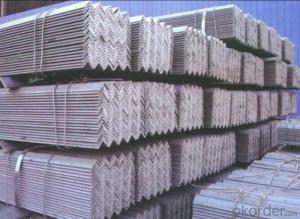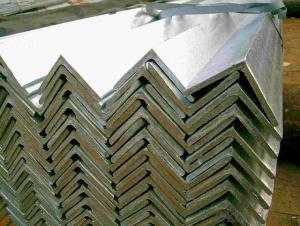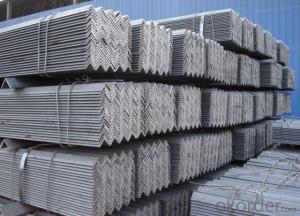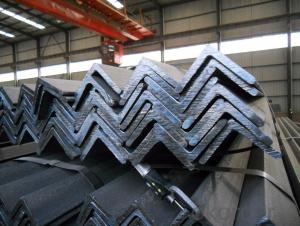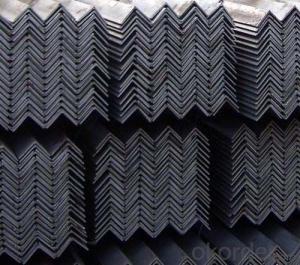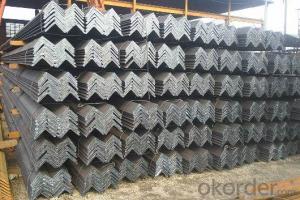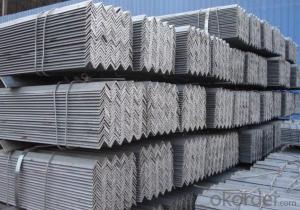Hot Rolled Steel Angle Bar with High Quality 25*25mm
- Loading Port:
- Tianjin
- Payment Terms:
- TT OR LC
- Min Order Qty:
- 25 m.t
- Supply Capability:
- 10000 m.t/month
OKorder Service Pledge
OKorder Financial Service
You Might Also Like
Product Description
Specifications of Equal Angle Steel
1.Standards:GB
2.Length:6m, 12m
3.Material:GBQ235 or Equivalent
4. Size:
Size (mm) | Mass (mm) | Size (mm) | Mass (mm) |
| 25*25*2.5 | 0.95 | 25*25*3 | 1.124 |
| 25*25*2.7 | 1.02 | 25*25*4 | 1.459 |
Usage & Applications of Equal Anlge Steel
Trusses;
Transmission towers;
Telecommunication towers;
Bracing for general structures;
Stiffeners in structural use.
Packaging & Delivery of Equal Angle Steel
1. Transportation: the goods are delivered by truck from mill to loading port, the maximum quantity can be loaded is around 40MTs by each truck. If the order quantity cannot reach the full truck loaded, the transportation cost per ton will be little higher than full load.
2. With bundles and load in 20 feet/40 feet container, or by bulk cargo, also we could do as customer's request.
3. Marks:
Color mark: There will be color marking on both end of the bundle for the cargo delivered by bulk vessel. That makes it easily to distinguish at the destination port.
Tag mark: There will be tag mark tied up on the bundles. The information usually including supplier logo and name, product name, made in China, shipping marks and other information request by the customer.
If loading by container the marking is not needed, but we will prepare it as customer request.
FAQ:
Q1: Why buy Materials & Equipment from OKorder.com?
A1: All products offered byOKorder.com are carefully selected from China's most reliable manufacturing enterprises. Through its ISO certifications, OKorder.com adheres to the highest standards and a commitment to supply chain safety and customer satisfaction.
Q2: How do we guarantee the quality of our products?
A2: We have established an advanced quality management system which conducts strict quality tests at every step, from raw materials to the final product. At the same time, we provide extensive follow-up service assurances as required.
Q3: How soon can we receive the product after purchase?
A3: Within three days of placing an order, we will arrange production. The shipping date is dependent upon the quatity, how many sizes you want and the plan of production, but is typically 30 to 45 days from the beginning of production.
Images:
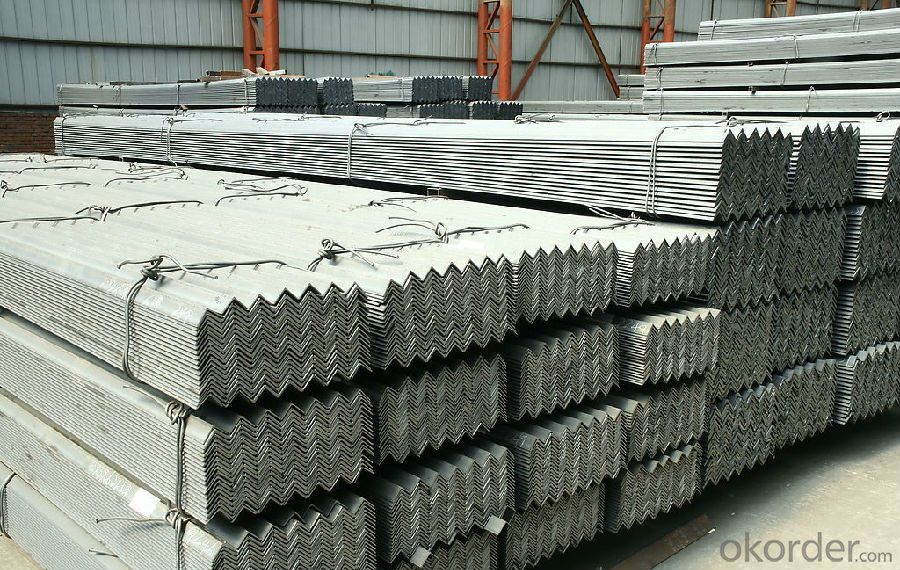
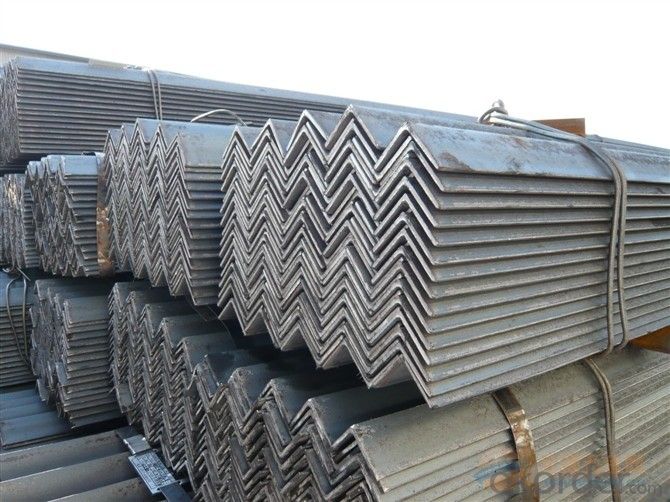
*If you would like to get our price, please inform us the size, standard/material and quantity. Thank you very much for your attention.
- Q: How do you determine the required size of a steel angle for a specific application?
- To determine the required size of a steel angle for a specific application, several factors need to be considered. These include the load or weight it needs to support, the angle's length and orientation, the type of steel being used, and any design codes or regulations that must be followed. Structural engineers typically perform calculations and analysis using equations and standards to determine the appropriate size of the steel angle to ensure it can handle the required load safely and efficiently.
- Q: How do steel angles contribute to the sustainability of transportation systems?
- Several ways contribute to the sustainability of transportation systems through the utilization of steel angles. To begin with, steel angles find wide use in constructing infrastructure, such as bridges, highways, and railway tracks. These structures boast a longer lifespan and necessitate fewer repairs and replacements compared to alternative materials. As a result, maintenance costs and resource consumption are reduced. Furthermore, steel angles possess exceptional durability and resistance to severe weather conditions. This quality ensures the longevity and safety of transportation systems. Consequently, the need for frequent repairs or replacements is minimized, thereby decreasing the overall environmental impact and carbon emissions associated with transportation infrastructure. In addition, steel angles possess a high strength-to-weight ratio, enabling the design of lighter and more fuel-efficient vehicles. Utilizing steel angles in the manufacturing process of automobiles, trains, and ships leads to reduced vehicle weight, thereby enhancing fuel efficiency and decreasing greenhouse gas emissions during operation. Moreover, steel angles can be easily recycled at the end of their lifecycle. Globally, steel is one of the most recycled materials, boasting a recycling rate of over 85%. By recycling steel angles, not only is the demand for virgin steel production reduced, but energy is also saved, and greenhouse gas emissions associated with extraction and manufacturing processes are decreased. Overall, the incorporation of steel angles in transportation systems promotes sustainability by fostering durability, decreasing maintenance needs, improving fuel efficiency, and enabling efficient recycling. These factors collectively contribute to minimizing the environmental impact and enhancing the long-term viability of transportation infrastructure.
- Q: Can steel angles be used for solar panel installations?
- Yes, steel angles can be used for solar panel installations. Steel angles provide structural support and stability for solar panels when they are mounted on rooftops or other structures. They are commonly used to create a framework or mounting system that securely holds the panels in place. Steel angles are strong and durable, able to withstand the weight of the panels and any external forces such as wind or snow loads. Additionally, steel angles can be easily fabricated and customized to fit specific installation requirements, making them a versatile choice for solar panel installations.
- Q: Can steel angles be used in the construction of hotels?
- Yes, steel angles can be used in the construction of hotels. Steel angles are commonly used in construction due to their durability, strength, and versatility. They can be used for a variety of purposes in hotel construction, such as supporting structural beams, reinforcing concrete slabs, framing walls, and creating architectural features. Steel angles provide stability and structural integrity, making them ideal for high-rise buildings like hotels. Additionally, steel angles are cost-effective and readily available, making them a practical choice for hotel construction projects.
- Q: What is the standard length of a steel angle?
- The standard length of a steel angle can vary depending on the specific requirements and standards set by the industry or project. However, in general, steel angles are commonly available in standard lengths of 20 feet or 6 meters. These standard lengths are often used for easy transportation, handling, and installation purposes. However, it is important to note that custom lengths can also be produced to meet specific project needs.
- Q: How are steel angles protected during transportation and storage?
- To ensure the preservation and quality of steel angles during transportation and storage, various measures are taken. One commonly employed method involves the application of a protective coating or paint to the surfaces of the steel angles. This coating acts as a barrier, shielding the angles from moisture and preventing the occurrence of rust and corrosion. Moreover, plastic wrapping or tarp covering can be utilized to safeguard the angles against dirt, dust, and other contaminants. During transportation, the risk of shifting or falling is minimized by securing the steel angles in bundles or arranging them in a manner that reduces such hazards. Additionally, pallets or skids may be employed to facilitate handling and prevent direct contact with the ground. When stored, it is crucial to keep the steel angles in a well-ventilated and dry area in order to prevent the accumulation of moisture. Furthermore, proper labeling and handling instructions play a vital role in preventing mishandling or damage during transportation. This entails the use of appropriate lifting equipment and avoidance of rough handling that could potentially lead to bending or deformation. By implementing these protective measures, the integrity and quality of steel angles can be upheld throughout the transportation and storage processes, ensuring their readiness for use.
- Q: What are the maximum allowable lengths for steel angles?
- In various applications and industries, the maximum lengths allowed for steel angles can vary depending on specific factors and regulations. These regulations are set by industry standards and guidelines. The maximum lengths are generally determined by considering the strength of the material, the intended load it will bear, and the structural design. Steel angles are commonly used in construction and engineering for framing, bracing, and support. The maximum lengths are often specified by building codes, engineering standards, or project-specific design criteria. These regulations ensure that the angles can withstand the anticipated loads and provide sufficient structural stability. To determine the maximum lengths for steel angles in a particular application, it is important to refer to the appropriate industry standards and regulations. It is also advisable to consult with a qualified structural engineer or designer. These professionals consider factors such as the dimensions, thickness, and material properties of the angle, as well as the specific load requirements. This ensures that the chosen length is safe and effective for meeting the project's needs.
- Q: What is the lifespan of a steel angle?
- The lifespan of a steel angle can be influenced by various factors including the quality of the steel, the environment in which it is exposed, and the level of maintenance it receives. Nevertheless, steel angles are generally renowned for their durability and long lifespan. By providing adequate care and regular maintenance, a steel angle can endure for numerous decades or even longer. Its lifespan can be significantly prolonged by the steel's resistance to corrosion, protective coatings, and measures taken to prevent rust and deterioration. Additionally, the load-bearing capacity, structural integrity, and overall design are vital in determining the lifespan of a steel angle. Therefore, it is crucial to consider the specific application and seek advice from professionals to ensure optimal performance and longevity.
- Q: How do steel angles contribute to sustainable construction?
- Steel angles contribute to sustainable construction in multiple ways. Firstly, steel is an incredibly durable and long-lasting material, which means that structures built using steel angles will have a longer lifespan compared to those made with other materials. This reduces the need for frequent repairs or replacements, thus minimizing waste and reducing the overall environmental impact of construction. Secondly, steel is a highly recyclable material. At the end of a structure's life cycle, steel angles can be easily recycled and repurposed for other construction projects. This reduces the demand for new steel production, which is energy-intensive and can result in significant carbon emissions. Additionally, steel angles offer design flexibility, allowing architects and engineers to create more efficient and innovative structures. This can lead to optimized building designs that require less energy for heating, cooling, and maintenance, contributing to energy savings and reduced greenhouse gas emissions. Moreover, steel angles are lightweight yet incredibly strong, resulting in less material usage and reduced transportation costs. As a result, the overall carbon footprint associated with steel construction is lower compared to other materials. Furthermore, steel angles have excellent fire resistance properties, making them a safer choice for construction. This increases the longevity of structures and reduces the risk of damage or destruction during fires. Consequently, the need for rebuilding or reconstructing is reduced, leading to less material waste and environmental impact. In conclusion, steel angles contribute to sustainable construction through their durability, recyclability, design flexibility, energy efficiency, lightweight nature, fire resistance, and overall reduced environmental impact. By incorporating steel angles into construction projects, we can create more sustainable and environmentally friendly structures that benefit both the present and future generations.
- Q: Can steel angles be used as a support for shelving?
- Yes, steel angles can be used as a support for shelving. Steel angles are sturdy and durable, making them suitable for bearing the weight of shelves and providing structural support.
Send your message to us
Hot Rolled Steel Angle Bar with High Quality 25*25mm
- Loading Port:
- Tianjin
- Payment Terms:
- TT OR LC
- Min Order Qty:
- 25 m.t
- Supply Capability:
- 10000 m.t/month
OKorder Service Pledge
OKorder Financial Service
Similar products
Hot products
Hot Searches
Related keywords













